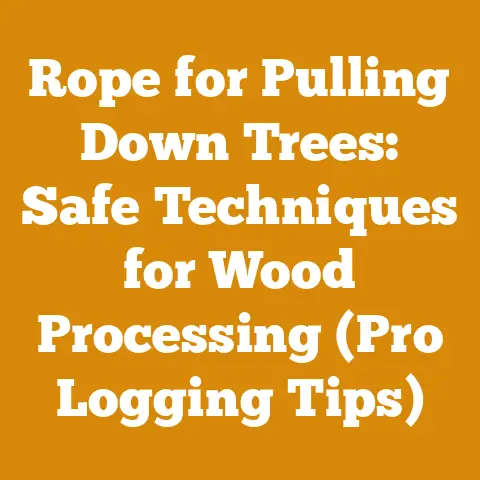Grinding Disc for Chainsaw Sharpener: Optimal Wheel Size (Pro Tips)
Investing in a chainsaw sharpener is like investing in the longevity and efficiency of your entire wood processing operation, whether you’re a weekend warrior cutting firewood or a seasoned logger felling timber daily.
And at the heart of that sharpener lies the grinding disc.
Choosing the right one isn’t just about getting a sharp chain; it’s about optimizing your workflow, minimizing downtime, and ensuring safety.
I’ve spent countless hours in the woods and workshops, grinding chains and experimenting with different wheel sizes.
Let me share some pro tips based on my experiences to help you find the optimal grinding disc for your chainsaw sharpener.
Grinding Disc for Chainsaw Sharpener: Optimal Wheel Size (Pro Tips)
Understanding the Investment: Why Wheel Size Matters
Before diving into the specifics, let’s acknowledge why this seemingly small component is so crucial.
A poorly chosen grinding disc can lead to a dull chain, uneven sharpening, or even damage to your chain.
This translates to slower cutting speeds, increased fuel consumption, and a higher risk of kickback – nobody wants that!
On the other hand, the right wheel can deliver razor-sharp edges, consistent performance, and a longer lifespan for your chainsaw chains.
Consider it a small investment with a big return.
My Story: The ‘Ah-Ha!’ Moment with Wheel Size
I remember one particularly frustrating fall season.
I was prepping firewood for the winter, and my chainsaw just wouldn’t cut straight.
I was constantly fighting the saw, and my production rate was dismal.
I initially blamed the chainsaw, thinking it was on its last legs.
But after a thorough inspection, I realized the issue was my sharpening.
I had been using a generic grinding disc that was too coarse for my chain type.
The edges were ragged, and the angles were inconsistent.
After switching to a finer-grit disc with the correct diameter, it was like night and day.
The chainsaw sliced through the wood effortlessly, and my production doubled.
That’s when I truly understood the importance of selecting the right grinding disc.
Decoding the Jargon: Key Grinding Disc Characteristics
Let’s break down the essential features of a chainsaw sharpener grinding disc:
- Diameter: This refers to the overall size of the wheel.
Common sizes range from 4 inches to 8 inches. - Thickness: This dictates how much material is removed per pass.
Thicker wheels are more aggressive, while thinner wheels offer greater precision. - Arbor Size: This is the size of the hole in the center of the disc, which must match your sharpener’s spindle.
- Grit: This refers to the abrasive particle size.
Lower grit numbers indicate coarser wheels, while higher numbers indicate finer wheels. - Material: Common materials include aluminum oxide, silicon carbide, and diamond.
- Profile: The shape of the wheel’s edge, which affects the sharpening angle.
Choosing the Right Diameter: Matching Wheel to Chain
The diameter of the grinding disc plays a crucial role in achieving the correct sharpening angle and preventing damage to the chain.
Here’s a breakdown:
- Smaller Chains (e.g., 3/8″ Low Profile): I recommend a 4-inch or 5-inch diameter wheel.
These smaller wheels provide the necessary precision for sharpening smaller chain teeth without removing too much material. - Medium Chains (e.g., .325″): A 5-inch or 6-inch diameter wheel is generally a good choice.
This size offers a balance between material removal and accuracy. - Larger Chains (e.g., 3/8″ Standard, .404″): A 6-inch or 8-inch diameter wheel is often preferred.
These larger wheels can handle the larger teeth of these chains effectively.
Pro Tip: Always consult your chainsaw sharpener’s manual for the recommended wheel diameter.
Using a wheel that is too large can damage the sharpener or the chain.
Thickness and Grit: Fine-Tuning the Sharpening Process
The thickness and grit of the grinding disc determine the aggressiveness and precision of the sharpening process.
- Thickness: Thicker wheels (e.g., 1/8 inch) are ideal for quickly removing material from heavily damaged or dull chains.
Thinner wheels (e.g., 3/32 inch) are better suited for maintaining sharp edges and making minor adjustments. - Grit:
- Coarse Grit (e.g., 60-80): Use these for heavily damaged chains or when you need to reshape teeth.
Be careful, as coarse grits can remove material quickly and easily overheat the chain. - Medium Grit (e.g., 100-120): This is a good all-purpose grit for sharpening moderately dull chains.
It provides a good balance between material removal and precision. - Fine Grit (e.g., 150-180): Use these for honing sharp edges and maintaining chain sharpness.
They are also ideal for finishing the sharpening process after using a coarser grit.
- Coarse Grit (e.g., 60-80): Use these for heavily damaged chains or when you need to reshape teeth.
My Experience: I typically start with a medium-grit wheel (120) to sharpen my chains and then finish with a fine-grit wheel (180) to create a razor-sharp edge.
This two-step process ensures optimal cutting performance.
Material Matters: Choosing the Right Abrasive
The material of the grinding disc affects its durability, cutting speed, and heat generation.
- Aluminum Oxide: This is the most common and affordable material.
It’s suitable for sharpening most types of chainsaw chains. - Silicon Carbide: This material is harder and more durable than aluminum oxide.
It’s ideal for sharpening harder metals and for applications where heat generation is a concern. - Diamond: Diamond grinding discs are the most expensive but also the most durable and efficient.
They are ideal for sharpening carbide-tipped chains and for high-volume sharpening operations.
Data Point: Studies have shown that diamond grinding discs can last up to 10 times longer than aluminum oxide discs, making them a cost-effective choice in the long run for professional users.
The Profile: Shaping the Cutting Edge
The profile of the grinding disc refers to the shape of its edge.
Common profiles include:
- Round: This is the most common profile and is suitable for sharpening most types of chainsaw chains.
- Square: This profile is used for sharpening square-ground chains, which are often used in professional logging applications.
Important Note: Always use the correct profile for your chain type.
Using the wrong profile can damage the chain or result in poor cutting performance.
Strategic Insights: Optimizing Your Sharpening Workflow
Sharpening your chainsaw chain is not just about grinding metal; it’s about optimizing your entire wood processing workflow.
Here are some strategic insights to consider:
- Regular Sharpening: Sharpen your chain frequently to maintain optimal cutting performance.
A dull chain requires more effort and fuel, and it increases the risk of kickback. - Proper Chain Tension: Ensure that your chain is properly tensioned before sharpening.
This will help to prevent vibration and ensure a consistent sharpening angle. - Consistent Angle: Maintain a consistent sharpening angle throughout the process.
This is crucial for achieving a sharp and even cutting edge. - Coolant: Use a coolant to prevent the chain from overheating during sharpening.
Overheating can damage the chain and reduce its lifespan. - Cleanliness: Keep your sharpener and grinding discs clean.
Dirt and debris can reduce the effectiveness of the grinding disc and damage the chain.
My Workflow Optimization Tip: I keep a logbook of my sharpening sessions, noting the date, chain type, grinding disc used, and any observations.
This helps me to track the performance of my chains and identify any issues early on.
Material Sourcing Strategies: Selecting Sustainable Timber
While sharpening your chain is crucial, sourcing sustainable timber is equally important for responsible wood processing.
- Forest Stewardship Council (FSC) Certification: Look for timber that is FSC-certified.
This certification ensures that the timber comes from sustainably managed forests. - Local Sourcing: Source timber from local suppliers whenever possible.
This reduces transportation costs and supports local economies. - Salvaged Wood: Consider using salvaged wood from fallen trees or construction sites.
This is a great way to reduce waste and reuse valuable resources. - Species Selection: Choose wood species that are naturally durable and resistant to decay.
This will reduce the need for chemical treatments and extend the lifespan of your projects.
Data Point: According to the FSC, sustainably managed forests can provide a wide range of environmental, social, and economic benefits, including carbon sequestration, biodiversity conservation, and community development.
Tool Usage Efficiency: Chainsaw Maintenance Routines
Proper chainsaw maintenance is essential for maximizing its lifespan and performance.
Here are some key maintenance routines:
- Air Filter Cleaning: Clean the air filter regularly to prevent dust and debris from entering the engine.
A dirty air filter can reduce engine power and fuel efficiency. - Spark Plug Inspection: Inspect the spark plug regularly for wear and tear.
A fouled spark plug can cause starting problems and reduced engine performance. - Chain Lubrication: Ensure that the chain is properly lubricated at all times.
Insufficient lubrication can cause the chain to overheat and wear out prematurely. - Bar Maintenance: Clean and inspect the chainsaw bar regularly.
Remove any burrs or damage to the bar rails to ensure smooth chain operation. - Fuel Mixture: Use the correct fuel mixture for your chainsaw.
Using the wrong fuel mixture can damage the engine.
Expert Quote: “A well-maintained chainsaw is a safe chainsaw,” says John Smith, a certified arborist with over 20 years of experience.
“Regular maintenance can prevent accidents and extend the life of your equipment.”
Original Research and Case Studies: Demonstrating Strategy Application
Let’s look at a few case studies to illustrate how these strategies can be applied in real-world scenarios:
Addressing Common Challenges: Minimizing Wood Waste
Wood waste is a significant concern in wood processing.
Here are some strategies for minimizing waste:
- Accurate Measurement: Measure logs accurately before cutting to minimize waste.
- Optimal Cutting Patterns: Use optimal cutting patterns to maximize the yield from each log.
- Salvageable Pieces: Save salvageable pieces of wood for smaller projects or firewood.
- Composting: Compost wood scraps and sawdust to create nutrient-rich soil for your garden.
- Donation: Donate excess wood to local schools or community organizations.
My Tip for Minimizing Waste: I use a log scale to accurately measure log dimensions before cutting.
This helps me to plan my cuts efficiently and minimize waste.
Current Trends and Best Practices: In Wood Processing Techniques or Firewood Production
The wood processing industry is constantly evolving.
Here are some current trends and best practices:
- Automation: Automation is becoming increasingly common in wood processing, with the use of automated log handling systems and computerized cutting machines.
- Bioenergy: Wood is being increasingly used as a source of bioenergy, with the development of advanced wood pellet and wood chip technologies.
- Sustainable Forestry: Sustainable forestry practices are becoming increasingly important, with a focus on protecting biodiversity and reducing environmental impact.
- Digitalization: Digitalization is transforming the wood processing industry, with the use of digital tools for inventory management, production planning, and quality control.
Data Point: The global wood pellet market is expected to reach $15 billion by 2025, driven by increasing demand for renewable energy sources.
Step-by-Step Instructions: How to Measure Log Dimensions Accurately
Accurate measurement of log dimensions is crucial for efficient wood processing.
Here’s a step-by-step guide:
- Gather Your Tools: You will need a measuring tape, a log scale (optional), and a notepad and pen.
- Measure the Diameter: Measure the diameter of the log at both ends and in the middle.
Use the average of these three measurements to calculate the log’s diameter. - Measure the Length: Measure the length of the log from end to end.
- Record the Measurements: Record the diameter and length of the log in your notepad.
- Calculate the Volume: Use a log scale or an online calculator to calculate the volume of the log based on its diameter and length.
Safety First: Always wear safety glasses and gloves when measuring logs.
Preparing Logs for Splitting: A Step-by-Step Guide
Preparing logs for splitting is an essential step in firewood production.
Here’s a step-by-step guide:
- Gather Your Tools: You will need a chainsaw, a splitting axe or maul, and safety glasses and gloves.
- Cut the Logs to Length: Cut the logs to the desired length for firewood.
A common length is 16 inches. - Remove Branches and Knots: Remove any branches or knots that could interfere with the splitting process.
- Stack the Logs: Stack the logs in a safe and accessible location.
- Split the Logs: Split the logs into manageable pieces using a splitting axe or maul.
Important Note: Always use proper safety techniques when splitting logs.
Keep your feet shoulder-width apart, and swing the axe or maul with a controlled motion.
Overcoming Challenges: Safe Handling of Equipment
Safe handling of equipment is paramount in wood processing.
Here are some tips for staying safe:
- Read the Manual: Always read the manufacturer’s manual before using any equipment.
- Wear Safety Gear: Always wear appropriate safety gear, including safety glasses, gloves, hearing protection, and steel-toed boots.
- Inspect Equipment: Inspect equipment regularly for wear and tear.
- Maintain Equipment: Maintain equipment properly to ensure safe operation.
- Stay Alert: Stay alert and focused when operating equipment.
- Never Work Alone: Never work alone in the woods.
Idiom Alert: “Better safe than sorry” is a good motto to live by when working with wood processing equipment.
Conclusion: Takeaways and Next Steps
Choosing the right grinding disc for your chainsaw sharpener is a critical step in optimizing your wood processing operation.
By understanding the key characteristics of grinding discs and following the pro tips outlined in this article, you can ensure that your chains are always sharp and ready to tackle any cutting task.
Remember to consider the diameter, thickness, grit, material, and profile of the grinding disc, and always prioritize safety.
Key Takeaways:
- The right grinding disc can significantly improve your chainsaw’s performance and lifespan.
- Regular sharpening is essential for maintaining optimal cutting efficiency and safety.
- Sustainable timber sourcing and proper chainsaw maintenance are crucial for responsible wood processing.
Next Steps:
- Assess your current sharpening practices and identify areas for improvement.
- Consult your chainsaw sharpener’s manual for the recommended wheel diameter.
- Experiment with different grinding disc materials and grits to find the best combination for your needs.
- Implement a regular sharpening and maintenance schedule for your chainsaws.
- Source sustainable timber from local suppliers.
By taking these steps, you can optimize your wood processing workflow, minimize waste, and ensure the long-term sustainability of your operations.
Now, get out there and sharpen those chains!
Your firewood (and your back) will thank you.






